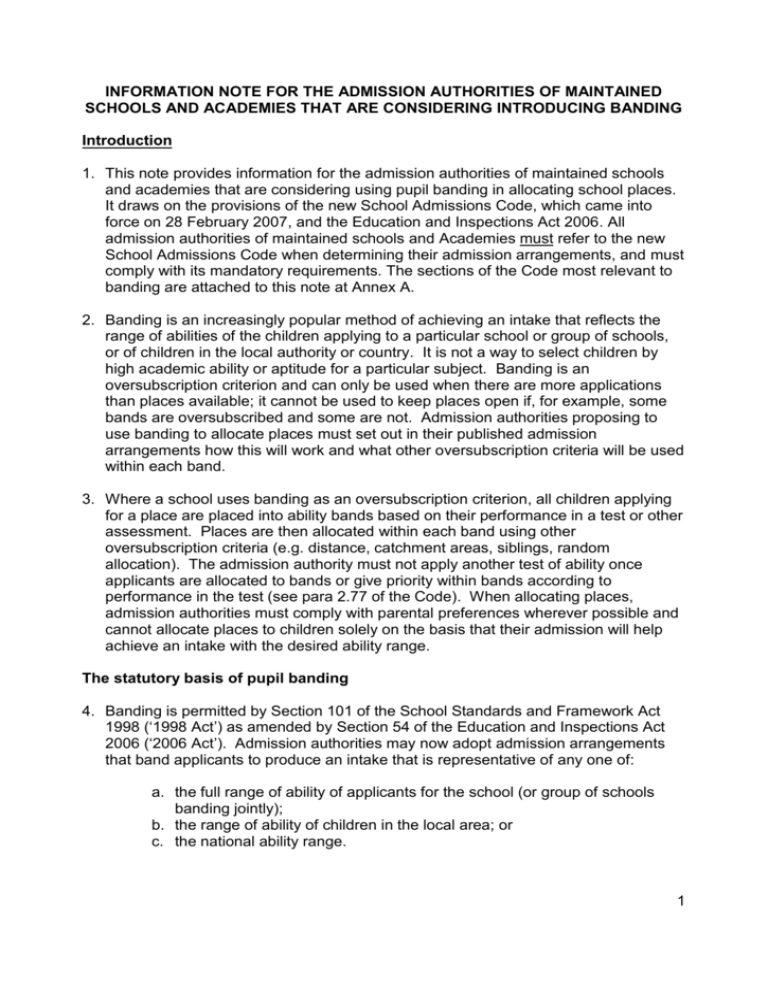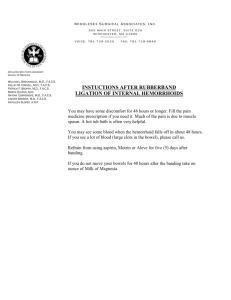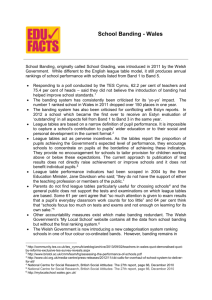tests schools
advertisement

INFORMATION NOTE FOR THE ADMISSION AUTHORITIES OF MAINTAINED SCHOOLS AND ACADEMIES THAT ARE CONSIDERING INTRODUCING BANDING Introduction 1. This note provides information for the admission authorities of maintained schools and academies that are considering using pupil banding in allocating school places. It draws on the provisions of the new School Admissions Code, which came into force on 28 February 2007, and the Education and Inspections Act 2006. All admission authorities of maintained schools and Academies must refer to the new School Admissions Code when determining their admission arrangements, and must comply with its mandatory requirements. The sections of the Code most relevant to banding are attached to this note at Annex A. 2. Banding is an increasingly popular method of achieving an intake that reflects the range of abilities of the children applying to a particular school or group of schools, or of children in the local authority or country. It is not a way to select children by high academic ability or aptitude for a particular subject. Banding is an oversubscription criterion and can only be used when there are more applications than places available; it cannot be used to keep places open if, for example, some bands are oversubscribed and some are not. Admission authorities proposing to use banding to allocate places must set out in their published admission arrangements how this will work and what other oversubscription criteria will be used within each band. 3. Where a school uses banding as an oversubscription criterion, all children applying for a place are placed into ability bands based on their performance in a test or other assessment. Places are then allocated within each band using other oversubscription criteria (e.g. distance, catchment areas, siblings, random allocation). The admission authority must not apply another test of ability once applicants are allocated to bands or give priority within bands according to performance in the test (see para 2.77 of the Code). When allocating places, admission authorities must comply with parental preferences wherever possible and cannot allocate places to children solely on the basis that their admission will help achieve an intake with the desired ability range. The statutory basis of pupil banding 4. Banding is permitted by Section 101 of the School Standards and Framework Act 1998 (‘1998 Act’) as amended by Section 54 of the Education and Inspections Act 2006 (‘2006 Act’). Admission authorities may now adopt admission arrangements that band applicants to produce an intake that is representative of any one of: a. the full range of ability of applicants for the school (or group of schools banding jointly); b. the range of ability of children in the local area; or c. the national ability range. 1 5. Section 54 of the 2006 Act also removed the requirement for admission authorities that wish to introduce banding to publish statutory proposals before doing so. Now they only need to consult on their plans to introduce banding as part of the annual consultation on their admission arrangements. Section 101 of the 1998 Act, as amended by section 54 of the 2006 Act, requires local authorities that wish to introduce banding at community or voluntary controlled schools for which they are the admission authority to secure the consent of the governing bodies of those schools before going out to wider consultation. Banding in Practice 6. Admission authorities can decide how many bands a school has and what proportion of children to place in each band, as long as they ensure that no level of ability is substantially under- or over-represented (as set out in Section 101 of the 1998 Act). 7. There are two main ways in which a school or group of schools can band – either to achieve an intake representative of the ability range of applicants to the school(s) (sometimes referred to as norm referenced banding), or to achieve an intake representative of the local authority area or national ability range (sometimes referred to as criterion referenced banding). Examples of how these might work in practice are given below. Norm Referenced Banding - to achieve an intake representative of the ability profile of those children applying to a school or group of schools. 8. Under norm referenced banding, all applicants are ranked according to their score in a common test. For example, if 200 children take the test, they will be ranked from 1 to 200 according to their performance. Each child’s ranking will depend on their score relative to the other children who took the test, and not on the actual scores achieved. The bands are then set according to the relative performance in that test. 9. Places are then allocated within each band using the school’s published oversubscription criteria. Whatever the number and size of the bands chosen, the proportion of applicants offered places from within each band mirrors the size of that band. For instance, if a school places the top 25% of applicants in the top band, the middle 50% in the next band, and the bottom 25% in the bottom band, 25% of its places are offered to children from the top band, 50% to children from the middle band, and a further 25% to children from the bottom band. Where a school uses proportionately sized bands, setting bands which are symmetrical either side of the median (see example b) below) will ensure the intake is not skewed in either direction. 2 Examples A school receives 200 applications and has a published admission number of 150. a) Equal sized bands Band Applicants in each band based on ranking in test Percentage of children allocated to each band Number of places allocated using oversubscription criteria 1 40 2 40 3 40 4 40 5 40 20% 20% 20% 20% 20% 30 30 30 30 30 1 20 2 40 3 80 4 40 5 20 10% 20% 40% 20% 10% 15 30 60 30 15 b) Proportionately sized bands Band Applicants in each band based on ranking in test Percentage of children allocated to each band Number of places allocated using oversubscription criteria Criterion Referenced Banding - to achieve an intake representative of the local authority or national ability profile. 10. Under criterion referenced banding, the scores that will form the boundaries of each band are already known as they are determined by either the national or local ability profile. Each applicant to a school, or group of schools, is placed in to the appropriate band according to their score in the relevant test. The proportion of children offered places from within each band is, as far as possible, proportionate to the size of the local or national band, and places must be allocated according to the published oversubscription criteria. If a particular band is undersubscribed, ie there are not enough applicants in that band to fill all of the places available, the remaining places should be evenly filled by children falling into the next nearest bands (ie the bands below or above). If the first child is taken from the band above then the next should be from the one below. An example of this is band 3 in example a) below. 3 Examples A school receives 200 applications and has a published admission number of 120. a) A nationally representative sample of the results of the 2006 QCA optional Year 5 tests in reading shows that: 19% of children achieved Level 5 (Band 1) 40% of children achieved Level 4 (Band 2) 24% of children achieved Level 3 (Band 3) 17% of children achieved below Level 3 (Band 4) All 200 applicants are placed in to the appropriate band above based on their score in the test and the proportion of children taken from each band will be, as far as possible, identical to the proportion nationally who fall in to that band, as stated above. Band Number of applicants to the school qualifying in each band Percentage of children nationally allocated to each band Number of places allocated using oversubscription criteria What happens 1 56 2 95 3 24 4 25 19% 40% 24% 17% 23 48 29 20 (i.e. 19% of 120) Admit 23 (i.e. 40% of 120) Admit 48 (i.e. 24% of 120) Admit all 24 plus 3 from Band 2 and 2 from Band 4 (or 2 from Band 2 and 3 from Band 4) (i.e. 17% of 120) Admit 20 b) Results of all children who sat an ability test in a local authority show that in the local area as a whole: 25% of children score between 85%-100% (Band 1) 25% of children score between 63%-84% (Band 2) 25% of children score between 45%-62% (Band 3) 25% of children score between 0%-44% (Band 4) All the applicants to the school are placed in to the appropriate band based on their score and 25% of children are then selected from within each band using the published oversubscription criteria. This has the effect of achieving an intake that reflects the abilities of children in the local area. 4 Band Number of applicants to the school qualifying in each band Percentage of children locally allocated to each band Number of places allocated using oversubscription criteria What happens 1 28 2 42 3 80 4 50 25% 25% 25% 25% 30 30 30 30 Admit all 28 plus 2 from band 2 Admit 30 Admit 30 Admit 30 11. If a group of schools were to adopt criterion referenced banding according to the examples above, it would ensure that an equal proportion of children of all abilities in an area were shared amongst the schools in that area, therefore ensuring a comprehensive intake in all the local schools. If the same set of applicants in example b) above were subject to norm referenced banding, an individual school would have ended up with an intake that had a disproportionate number of lower ability children compared to the number in the local area. In example b), of the 200 children who applied to the school, 130 children (65%) scored 62% or less in the test compared with 50% in the local area as a whole. If, under norm-referencing, the school set 5 bands with 40 children in each, the bottom 3 bands would be filled with the lower ability children and the school would be required to take 20% from each band, which would result in the school admitting a minimum of 60% of lower ability children in that year, compared to 50% under criterion-referencing. Frequently asked questions Q1. What are the advantages of banding? Banding is a method of achieving an intake which is representative of a wide range of abilities. It can also widen the geographical area from which pupils are drawn, opening up access to popular schools to a wider range of families, not just those who can afford to buy a property near the school. Operating banding across a group of schools or a whole local authority area can reduce segregation by ability within that area. Q2. Do admission authorities have to use banding? No. Banding is just one method for allocating places at oversubscribed schools which admission authorities may use. 5 Q3. In what circumstances can banding be good practice? Banding can be more effective in urban, rather than rural, areas where there is often a greater concentration of schools serving a number of children. Banding can help to reduce segregation, particularly if used together with inner and outer catchment areas as this can help to ensure an intake with both a broader ability range and wider social mix than would be the case if distance alone was used. However, every local area is different and admission authorities will need to decide if banding is likely to have the desired effect in their area. Academies are encouraged to consider using banding as their main purpose is to provide education to children of all abilities in their area. Q4. Can partially selective schools band? Admission authorities that select up to 10% of children on the basis of aptitude are also allowed to use banding (see para 2.83 of the Code). In this situation, they could admit the first 10% of children on the basis of aptitude and band the remaining 90%, or band children first and then admit 10% of each band on the basis of the relevant aptitude. Schools which use partial selection by ability or aptitude that existed at the beginning of the 1997/98 school year and which could not now be lawfully introduced (‘pre-existing partial selection’) cannot use banding to allocate their non-selective places. This is because under Section 100(1) of the School Standards and Framework Act 1998, they cannot increase the proportion of selective admissions to the school in any year, and introducing banding would have this effect. Q5. If only one or a small group of schools in an area use banding will this amount to covert selection by ability by those schools? No. The effect of one school or a small group of schools in an area using banding on other schools in the area will depend on the local circumstances. If the school that introduces banding previously had a broad ability intake, there is likely to be little effect on neighbouring schools. If that school previously had a high ability intake because, for example, it used distance as its main oversubscription criterion and the majority of local children are of high ability, introducing banding will broaden its ability range and therefore could result in a greater number of high ability pupils being admitted to neighbouring schools. However, all of this is dependent on local circumstances including the pattern of applications. Q6. There is no transparency around how admission arrangements are applied. Why don’t admission authorities have to publish the results of the tests used for banding, and details of how they have applied their oversubscription criteria within the bands? There is transparency in the admissions system. All admission authorities are required to consult widely on their proposed arrangements each year, and bodies that have been consulted with have the right to object to the Schools Adjudicator about those arrangements. Furthermore, admission authorities are required to publish their determined arrangements and make these available to parents in their school’s prospectus. If parents are denied a place at a school for their child they have the right of appeal to an independent appeals panel, and the panel will consider whether the school’s published admission arrangements have been correctly applied. 6 It is expected that if asked, admission authorities would provide information on the results of tests and how oversubscription criteria were applied to the DCSF, local authority (if they are not the admission authority) or Admission Forum. Forums also examine admission arrangements, including how banding systems work, and have the right to object to the Adjudicator. However, the DCSF does not require information on how oversubscription criteria have been applied to be published; this would create unnecessary bureaucracy. In the interests of transparency, schools that are their own admission authority could agree that their local authority applies their oversubscription criteria, including banding, on their behalf. Q7. Tests used for banding are often held at times that are difficult for single parent families, families where both parents work or where one or more parents work shifts, a greater proportion of whom may be from more disadvantaged social groups. Won’t this discourage these families from applying to schools which use banding? The School Admissions Code says that tests should be at times likely to be convenient to parents with varying working patterns (para 2.88), and admission authorities must ensure that test arrangements are explained clearly to parents and that adequate notice is given on the location and length of tests (para 2.85). It also says that ‘where a number of schools in an area band, they should use a common test’ so that children applying to more than one of those schools only need to take one test. If schools use the results of the QCA Year 5 optional tests to band, which are conducted in the majority of primary schools, then this removes the problem as these tests will take place within normal school time. Admission authorities must not refuse to admit a child solely because they are unable to sit the test on the allocated date. In this circumstance they could arrange for another test to be conducted, or seek other evidence of the child’s academic ability. Q8. Many parents, often from more disadvantaged social groups, think that their child must pass or obtain a certain score in the test used for banding, in order to have any chance of being admitted to the school. Won’t this discourage them from applying to schools which use banding? It is very important that parents have all the information they need when applying for a school place, including how the system works. Admission authorities that use banding must make clear how banding works so that parents understand the purpose of the test, that there is no pass or fail, and how the results are actually used. The Choice Advice service, which offers impartial, practical advice and support to those parents identified as most likely to need help in navigating the admissions system (who are more likely to be from disadvantaged social groups) will help more parents to understand how banding works so they are not discouraged from applying to schools which use banding. Q9. When considering applications during the normal admissions round, are admission authorities required to consider children who have not sat the banding test? Yes. Parental preferences must always be considered, even if a child does not complete a test for banding, whether this is a result of the family not wanting the child to sit the test, or that the child missed the test date for whatever reason. Admission authorities can state in their arrangements that, apart from children with statements of 7 Special Educational Needs or children in care (who may not be required to sit a banding test), children who have sat the test and can be allocated to ability bands will be considered for available places before those who have not. Q10. Are admission authorities of schools which use banding required to inform parents of the outcome of banding tests, before the parents make their applications for other schools? The School Admissions Code says that parents should be informed of the results of tests before they express their preferences (para 2.92), but this is not a mandatory requirement. Parents need to be able to access a wide range of information if they are to make fully informed choices when applying to schools, and admission authorities should carefully consider whether it is necessary and/or practicable to make test results available. However, unlike some grammar and partially selective schools, schools that band do not set a pass or fail mark and therefore knowing the results of the test may not add any value to the parents’ decision making. Where schools use the QCA optional Year 5 test for the purposes of banding, this is no longer an issue for consideration as the results are known well in advance of the deadline for secondary applications. Q11. When admitting children in-year/outside the normal admissions round, schools which use banding are not required to take account of the bands children would fall into. This could result in a greater proportion of high or low ability children being admitted to a school - doesn’t that defeat the object of banding? Where an admission authority which uses banding receives applications in-year or outside the normal admissions round, it must not refuse admission solely because the child hasn’t taken the banding test. It is not necessary to band in year applicants, as the numbers of children this involves is so small that it is unlikely to result in the ability range of a school’s intake being skewed to such an extent that it would noticeably dilute the effect of using banding in the first place. The School Admissions Code requires every area to have an In Year Fair Access Protocol from September 2007 onwards. These protocols outline the fair method to be used to secure the admission of children without a school place outside the normal admissions round/point of entry as quickly as possible. Q12. Does banding have to be applied to those children on a waiting list? Admission authorities do not need to apply banding to children placed on a waiting list (that is maintained after the co-ordination process has been completed), as the effect on the ability profile of the school of admitting the small number of children that may gain places after being on a waiting list will be minimal. Children on a waiting list must be ranked in the order of how they meet the school’s published oversubscription criteria (for a school that bands, this is the criteria used to rank children within each band). Maintaining a waiting list in this way also allows admission authorities to place late applicants on the list without arranging supplementary tests. This does not apply to waiting lists held as part of co-ordination, where banding would still need to be applied. 8 Q13. How can schools which use banding ensure that children from all backgrounds are applying and being admitted to the school? There is no evidence to suggest that banding schools skew admissions away from disadvantaged social groups. Furthermore, the School Admissions Code (paras 1.901.91) encourages all admission authorities to analyse information on their intakes and their applicants to find out whether or not they attract a wide range of families. If this information suggests that their policies or practices appear to be unfairly disadvantaging one group of children compared to another, they must act upon it. They could do this in a number of ways, for example they could work with primary schools in disadvantaged areas (eg those with high numbers of pupils receiving Free School Meals) to encourage applications from their pupils. Admission Forums will also be assessing how admission arrangements promote fair access and equity. Q14. Doesn’t banding reduce the chances of siblings getting into the same school? It is up to individual admission authorities to decide on whether to use the sibling criterion and what priority to give it in their oversubscription criteria. If using banding, admission authorities can choose to have the sibling criterion as the first oversubscription criterion (after children in care) when allocating places within each band. 9 Annex A Extract on Banding from the School Admissions Code Banding 2.77 Banding, like other oversubscription criteria, only operates when the number of applications exceeds the number of places. Schools which use banding must not apply another test of ability once applicants are allocated to bands; they must not give priority within bands according to performance in the test. The admission authority must apply its other oversubscription criteria (such as random allocation) to each band to allocate places. 2.78 Banding is permitted by section 101 of the School Standards and Framework Act 1998, as amended by section 54 of the Education and Inspections Act 2006. The Education and Inspections Act 2006 removed the need for approval of statutory proposals before the introduction of banding arrangements, and this can now be done as part of the annual admissions consultation process. 2.79 Pupil ability banding is used by some admission authorities to ensure that their intake includes a proportionate spread of children of different abilities. Banding arrangements are good practice, provided the arrangements are fair, objective and not used as a means of unlawfully admitting a disproportionate number of high ability children. 2.80 Banding may be adopted in relation to individual schools, two or more schools operating together, or across a local authority area. Banding arrangements which are already in place may continue unchanged but the admission authorities for a school or groups of schools working together may now adopt admission arrangements that band applicants to produce an intake that is representative of: a) the full range of ability of applicants for the school(s); or b) the range of ability of children in the local area; or c) the national ability range. 2.81 If places become vacant in some bands, for example, because parents accept offers of places at other schools, and no applicants in those bands remain without a place, they should be evenly filled by children falling into the next nearest bands (i.e. the bands on either side, or below or above, if the first child is from the band above then the next should be from the one below). 10 Banding that existed prior to the School Standards and Framework Act 1998 2.82 Banding which it would not be possible to introduce now - for example, because the effect is to favour high ability children disproportionately - but which was in place at the beginning of the 1997/98 school year and continuously since then on the same basis, may continue. This is allowed as a form of pre-existing partial selection and any admission authorities with such arrangements are required to publish a notice explaining their arrangements in a local newspaper, giving parents the opportunity to object to the Adjudicator about the arrangements. Partial selection by aptitude and banding 2.83 Section 101(5) of the School Standards and Framework Act 1998 allows admission authorities which use banding also to admit up to 10% of children in total on the basis of aptitude for one or more of the prescribed subjects. So, for example, admission authorities are able to admit the first 10% of children on the basis of aptitude and band the remaining 90%, or band children first and then admit 10% of each band on the basis of the relevant aptitude. Children with special educational needs and banding 2.84 Children with special educational needs can be included in banding arrangements, that is they can be allocated to the band appropriate to their ability, but schools must not refuse to admit a child with a statement that names the school. Requirements as to tests Test arrangements for banding and partial selection by aptitude 2.85 It is up to the admission authority to decide which tests will be used to determine the band in which to place an individual child, but it must ensure that any test arrangements (including the reasons for testing) are explained clearly to parents and that adequate notice is given on the location and length of tests. Where a number of schools in an area band, they should use a common test, such as the results of QCA Year 5 optional tests conducted in primary schools, to ensure that children are not required to take more than one test. 2.86 Whatever form of test is used to band, it must be designed to give an accurate reflection of the abilities of all children irrespective of sex, race or disability. 11 2.87 Tests, assessments or auditions used to identify whether a child has an aptitude for a particular subject must be objective, have a distinctive subject focus and must not discriminate against applicants on the grounds of sex, race, disability or family background. And the assessment must test only for the subject aptitude concerned and not for ability or any other aptitude or for prior learning or experience in the subject. If there are two or more schools using tests in an area the same aptitude test should be used. General provisions relating to all tests 2.88 Tests should be at times likely to be convenient to parents with varying working patterns. 2.89 Admission authorities must not adjust the score achieved by any child in a test in order to take account of oversubscription criteria, such as having a sibling at the school. 2.90 It is unlawful to charge a fee for, or in connection with, admission to any maintained school. This includes fees designed to cover the administrative costs of selection and testing arrangements, even if these are refundable to successful candidates. Inviting parents to give voluntary financial support to the school, however conditional, before admission decisions are taken could be seen as a disguised fee and is unlawful. 2.91 Admission authorities must ensure that tests are accessible to children with special educational needs and disabilities. For example, it may be appropriate to make available test material in an adapted format, or allow additional time, or a scribe, depending on the individual needs of the child. 12








